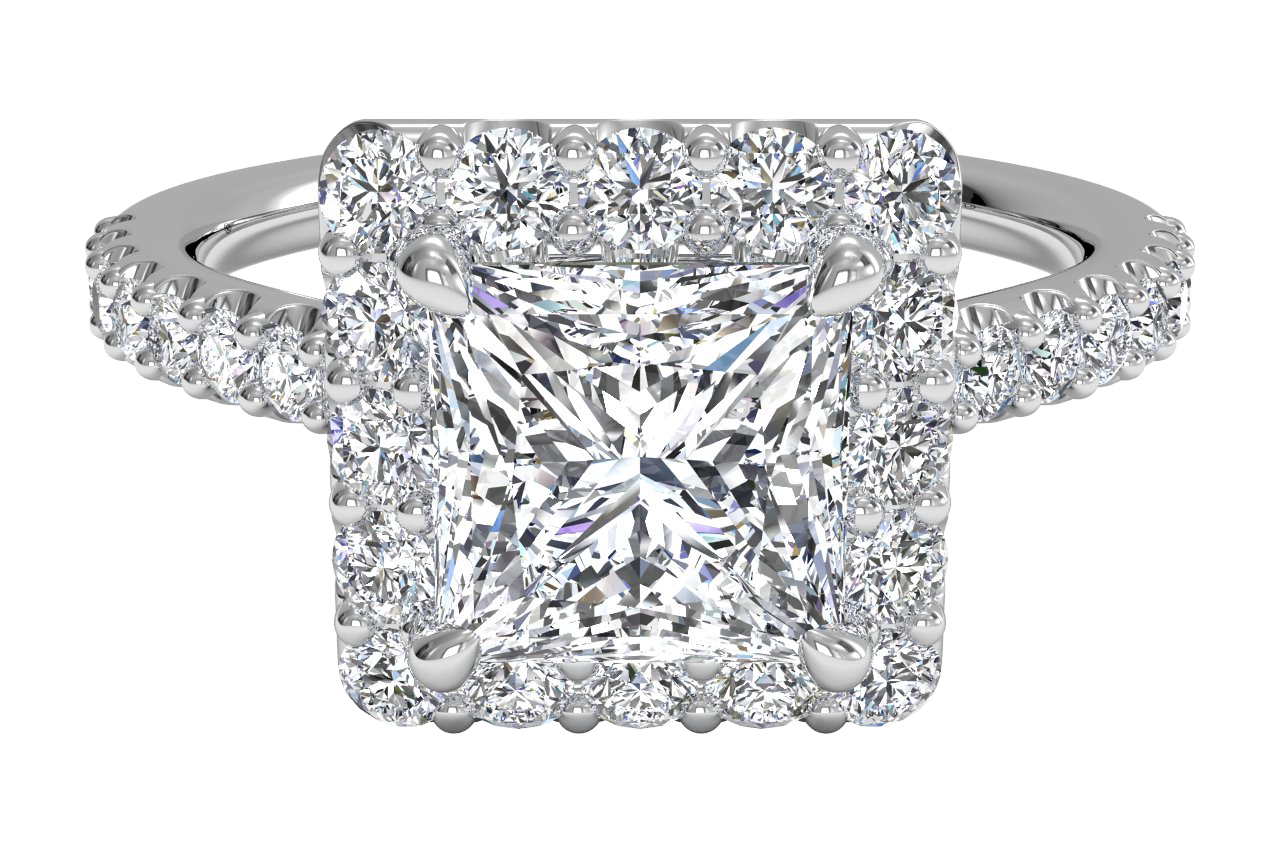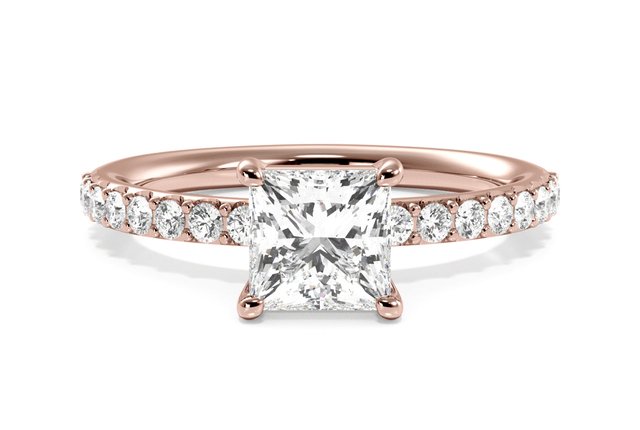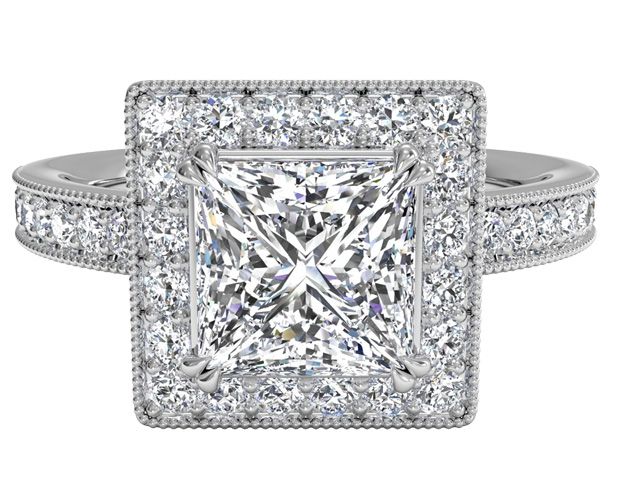September 29, 2022
Princess Cut Engagement Ring Buying Guide

The princess-cut diamond, developed in the 1980s, is prized for its stunning clean sparkle from its square shape, sharp angles and ample brilliance. The princess-cut is a cost-effective alternative to the classic round-cut diamond. It’s perfect for those who want a modern diamond with maximum brilliance.
What is a princess-cut diamond? What does a princess-cut diamond look like?
A princess-cut diamond is a square-cut stone, inspired by the antique French cut diamond. The princess diamond must have a length-to-width ratio between 1.00 and 1.05 to maintain a perfect square shape. Most jewelers will provide the stone’s length to width ratio, but if they don’t, you can easily calculate it by dividing the stone’s length and width, which is noted in the grading report.
What to look for in a Princess-cut diamond
Before you begin your search, it's crucial to become acquainted with the 4 Cs. The 4 Cs are the industry-wide standard way to determine the quality and value of a diamond. The 4 Cs stand for Cut, Color, Clarity, and Carat.
Cut
When searching for a princess-cut diamond, the cut of the stone is extremely important because it determines any diamond’s sparkle. The four cut gradings range from Ideal, Very Good, Good and Poor. The Gemological Insititute of America (GIA) doesn’t assign cut grades to diamonds other than a round-cut. At Ritani we give fancy shapes a Very Good or Good rating. We recommend that you view HD videos of your diamond before making a purchase. You can also preview your diamond for free at a store or WeWork near you – there's no obligation to make a purchase.
Color

Diamonds are graded on their color, which determines how much (or how little) color a diamond will show. The diamond scale goes from D (no color) to Z (obvious yellow or brown). At Ritani, the lowest color grade we offer is L. For the best color and price for your princess-cut ring, we recommend a minimum color of I for your princess-cut diamond. This color grade will still face up as a white diamond, and can help you save hundreds of dollars.
Choosing a rose gold or yellow gold setting? You can go as low as a J, K, or L colored diamond. These diamond colors can help you save even more and will pair beautifully with warmer-colored metals.
Clarity

Diamonds receive a clarity grade, which refers to how many (or how few) inclusions & blemishes they have. Inclusions are imperfections on the inside of the diamond. Blemishes are imperfections that occur from polishing or setting the diamond. Princess diamonds are prone to chipping if an inclusion is in one of the four sharp corners. Be sure to check the inclusion report to make sure there are no inclusions in the corners. The modified brilliant facet pattern of a princess-cut diamond can hide certain imperfections. As far as grading, choose a minimum clarity grade of VS2 or better to ensure an eye-clean diamond. Always view HD imagery and/or videos of your diamond before making a purchase!
Carat
Carat refers to the weight of the diamond, although it also is related to how big the diamond looks. The average carat weight for an engagement ring in the U.S. is about 1 carat.
To save on your diamond, we recommend buying shy. This means that if you are looking for a 1 carat diamond, choose a diamond in the 0.90-0.99 carat range. These diamonds will be identical in size to a 1-carat diamond but can help you save hundreds of dollars.

How to Measure a Princess Cut Diamond
Measurements can vary from one-carat weight to the next. A princess-cut diamond is measured by length x width in millimeters.
Below are the approximate measurements in millimeters of popular princess-cut diamond carat weights. Please note that the size of a diamond in millimeters can vary depending on the stone’s cut quality and length-to-width ratio.
| Size in mm | Princess-cut Diamond Carat Weight |
| 3.47 × 3.47 mm | 0.25 carat |
| 4.37 × 4.37 mm | 0.50 carat |
| 5.01 × 5.01 mm | 0.75 carat |
| 5.51 × 5.51 mm | 1 carat |
| 5.94 × 5.94 mm | 1.25 carat |
| 6.31 × 6.31 mm | 1.50 carat |
| 6.64 × 6.64 mm | 1.75 carat |
| 6.94 × 6.94 mm | 2 carat |
What settings pair best with a Princess-Cut Diamond?
Solitaire

The solitaire setting refers to an engagement ring set with one diamond. In this case, if you are looking for a classic engagement ring style using a princess-cut diamond, the solitaire setting is the way to go.
Halo

In the halo setting, the center diamond is surrounded by smaller accent diamonds, providing extra brilliance. The halo optically extends the size of the center diamond, making it appear larger.
Sidestone

Sidestone engagement rings are made up of the center diamond and smaller stones on each side. Usually, the smaller accent stones are one shape and style.
Three Stone

The three-stone setting uses two smaller diamonds to accent the center diamond. Some prefer to use the same shaped diamond as the accent, while others use the same shape. This romantic setting is said to represent your past, present, and future together.
Vintage

Vintage-inspired engagement rings are growing in popularity. Taking designs from rings that are decades or centuries old, vintage-inspired rings frequently feature bezel settings, milgrain details, and bold, ornate designs.
Ideal Table and Depth for a Princess-Cut Diamond
The table of a diamond refers to the flat, topmost surface of the diamond. It’s important to choose the right table size because a table that is too small or too large won’t reflect light as well, thus affecting the diamond’s sparkle. A diamond’s depth is the measurement from the top of the stone (the table) to the bottom of the stone (the culet). The right depth is important because a stone that is too shallow or too deep won’t sparkle as much. The ideal depth for a princess-cut diamond is between 64 and 75 percent while its ideal table percentage is between 67 and 72 percent.
By now, you are hopefully feeling like a princess-cut diamond expert. If you need further assistance choosing the right diamond and/or setting, our non-commissioned virtual gemologists are ready to provide advice. Ready to design your princess-cut diamond engagement ring?
Frequently Asked Questions
How Big is a Half Carat Princess-Cut Diamond?
The average size of a half-carat princess-cut diamond is 4.5 mm.
How Many mm is a 1-Carat Princess-Cut Diamond?
On average, a 1-carat princess-cut diamond is 5.5 mm.
How Much is a 4-Carat Princess-Cut Diamond Ring?
The cost of any 4-carat diamond can range depending on its cut, color, and clarity grades. You can explore our inventory of 4-carat princess diamonds here.
Learn more about Princess-Cut Diamonds here:


